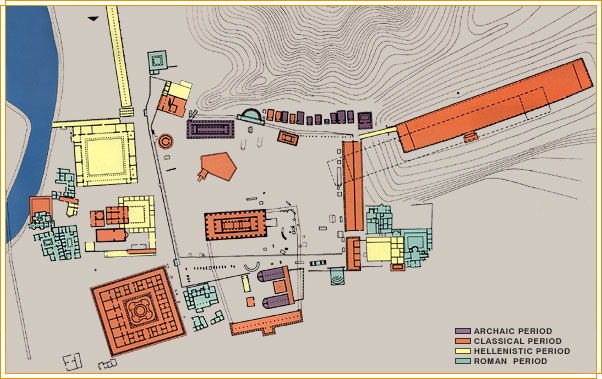 |
|
|
|
||
|
Topography of Ancient Olympia |
|||

|
|||
|
The Temple of Zeus Introduction | statue | metopes | pediments The decoration of the pediments. The east and west pediment bore refined compositions made of Parian marble that belonged to the Severe style. The sculptor placed the statues along the axis of the pediments. The east pediment depicts the legendary chariot-race between Pelops, king of Lydia, and the king of Pisa, Oenomaos. According to the legend, king Oenomaos had promised his daughter, Hippodameia, to the winner of a chariot-race. In the east pediment the artist introduces the main figures of the story. In the middle of the pediment, Zeus judges the race. The two main characters of the myth, Pelops and Oenomaos encircle Zeus. Hippodamia and Sterope stand next to Pelops and Oenomaos respectively. Next follow two young figures on their knees, a man on the left and a woman on the right. Two groups of horses dragging chariots follow next. The elderly man on the right side of the pediment is considered to be the Oracle who has foreseen Oenomaos' death. A young man, not yet identified, is standing next to him. Pausanias, who had visited Olympia in the 2nd century BC, has identified the lying figures of two young men in the edge of each side as personifications of the rivers Kladeus (right) and Alpheus (left). The west pediment depicts a battle among the Centaurs and the Lapiths. Compared with the style of the east pediment the scene is filled with motion. According to the myth, the Centaurs, when invited to King Pirithous' wedding, got drunk and attempted to kidnap the Lapiths' wives and male children. Apollo stands in the middle of the composition and intervenes to restore the order. A group consisting of three figures follows next: the Centaur Eurytion, who snatches Pirithous' spouse and a Lapith about to attack him. Next to them a Centaur is grabbing a child. Another Centaur who has grabbed a Lapith girl is depicted on their left, while the same scene is depicted on Apollo's right. According to Pausanias, the man with the ax standing next to Apollo is Theseus. Next to that complex there are two pairs of Centaurs fighting with the Lapiths. The composition is completed with two Lapith women in the two edges of the pediment. |
